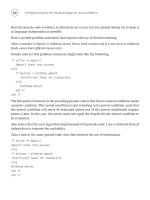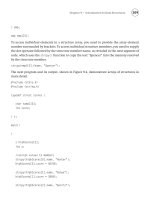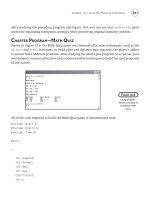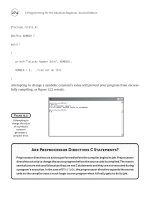PHP for Absolute Beginners PHẦN 9 ppt
Bạn đang xem bản rút gọn của tài liệu. Xem và tải ngay bản đầy đủ của tài liệu tại đây (1.18 MB, 41 trang )
CHAPTER 10 ADDING A COMMENTING SYSTEM TO YOUR BLOG
309
{
// If set, store the entry from which we came
$loc = isset($_POST['url']) ? $_POST['url'] : ' /';
// If the user clicked "Yes", continue with deletion
if($_POST['confirm'] == "Yes")
{
// Include and instantiate the Comments class
include_once 'comments.inc.php';
$comments = new Comments();
// Delete the comment and return to the entry
if($comments->deleteComment($_POST['id']))
{
header('Location: '.$loc);
exit;
}
// If deleting fails, output an error message
else
{
exit('Could not delete the comment.');
}
}
// If the user clicked "No", do nothing and return to the entry
else
{
header('Location: '.$loc);
exit;
}
}
else
{
header('Location: /');
exit;
}
?>
Download at WoweBook.Com
CHAPTER 10 ADDING A COMMENTING SYSTEM TO YOUR BLOG
310
At this point, you can delete comments from the database, thus removing them from your entry
display. You can test this out by deleting your test comment. Navigate to the entry that you we entered
for the comment in a browser, then click the delete link. Next, click Yes to confirm that you want to
delete the comment. This takes you back to the entry, but the comment is no longer there. Instead, you
see the default message: “There are no comments for this entry” (see Figure 10-6).
Figure 10-6. After deleting your test comment, you see this default message
Summary
In this chapter, you learned how to add an interactive element to your blog by allowing users to
comment on your blog entries. In doing so, you also learned a little more about object-oriented
programming.
In the next chapter, you’ll learn how to build a login system that lets you hide administrative
controls from users who aren’t logged in, giving you better control over your blog.
Download at WoweBook.Com
C H A P T E R 11
311
Adding Password Protection
to Administrative Links
One of the last things you need to add before you can call your blog “web-ready” is to hide the
administrative links from users who aren’t authorized to view them. In this chapter, you’ll learn how to
build a system that lets you create administrators and require them to log in with a password before they
can create, edit, and delete entries on the blog.
Creating this system requires that you master the following tasks:
• Adding an admin table to the simple_blog database
• Building a function to place administrators in the admin table
• Using sessions to hide controls from unauthorized users
• Creating a login form that allows administrators to log in to the blog
• Writing code to check submitted form data and display its controls if valid
Adding an admin Table to the Database
Enabling administrators for your site requires that you create a table to store their information. This
simple table, admin, stores the following information:
• username: The administrator’s login name
• password: The administrator’s password
Your username needs to be unique, so make it the table’s primary key. Specify both fields as of
the VARCHAR type, limit the username to 75 characters, and limit the password to 40 characters.
To create the admin table, navigate to http://localhost/phpmyadmin in a browser and open the
SQL tab. Enter the following command to create your table:
CREATE TABLE simple_blog.admin
(
username VARCHAR(75) PRIMARY KEY,
password VARCHAR(40)
)
Download at WoweBook.Com
CHAPTER 11 ADDING PASSWORD PROTECTION TO ADMINISTRATIVE LINKS
312
Adding Administrators in the Database
You have a place to store administrators; now you’re ready to start creating them. Your first step is to
create a form that allows you to enter a username and password in an HTML form. Once you accomplish
this, you need to store the information in the database for later use.
Building an HTML Form
To build your HTML form, you need to write a new function, named createUserForm(). When called, this
function returns a string of HTML that displays a form that asks for a username and password for the
new admin.
You can add the code in bold to functions.inc.php to make the createUserForm() function:
function createUserForm()
{
return <<<FORM
<form action="/simple_blog/inc/update.inc.php" method="post">
<fieldset>
<legend>Create a New Administrator</legend>
<label>Username
<input type="text" name="username" maxlength="75" />
</label>
<label>Password
<input type="password" name="password" />
</label>
<input type="submit" name="submit" value="Create" />
<input type="submit" name="submit" value="Cancel" />
<input type="hidden" name="action" value="createuser" />
</fieldset>
</form>
FORM;
}
Next, you need to add code to call this function if the user chooses to create a new admin. Use
the http://localhost/simple_blog/admin/createuser URL as your call to create a new admin for your
blog.
To make this URL call the createUserForm() function, you need to add an if block to admin.php
that triggers when the $page variable you use to determine what page is being edited is set to createuser.
Next, modify admin.php with the code in bold to incorporate the new form into your blog:
<?php
/*
* Include the necessary files
*/
Download at WoweBook.Com
CHAPTER 11 ADDING PASSWORD PROTECTION TO ADMINISTRATIVE LINKS
313
include_once 'inc/functions.inc.php';
include_once 'inc/db.inc.php';
// Open a database connection
$db = new PDO(DB_INFO, DB_USER, DB_PASS);
if(isset($_GET['page']))
{
$page = htmlentities(strip_tags($_GET['page']));
}
else
{
$page = 'blog';
}
if(isset($_POST['action']) && $_POST['action'] == 'delete')
{
if($_POST['submit'] == 'Yes')
{
$url = htmlentities(strip_tags($_POST['url']));
if(deleteEntry($db, $url))
{
header("Location: /simple_blog/");
exit;
}
else
{
exit("Error deleting the entry!");
}
}
else
{
header("Location: /simple_blog/blog/$_POST[url]");
}
}
if(isset($_GET['url']))
{
$url = htmlentities(strip_tags($_GET['url']));
// Check if the entry should be deleted
if($page == 'delete')
{
$confirm = confirmDelete($db, $url);
}
Download at WoweBook.Com
CHAPTER 11 ADDING PASSWORD PROTECTION TO ADMINISTRATIVE LINKS
314
// Set the legend of the form
$legend = "Edit This Entry";
$e = retrieveEntries($db, $page, $url);
$id = $e['id'];
$title = $e['title'];
$img = $e['image'];
$entry = $e['entry'];
}
else
{
// Check if we're creating a new user
if($page == 'createuser')
{
$create = createUserForm();
}
// Set the legend
$legend = "New Entry Submission";
// Set the variables to null if not editing
$id = NULL;
$title = NULL;
$img = NULL;
$entry = NULL;
}
?>
<!DOCTYPE html
PUBLIC "-//W3C//DTD XHTML 1.0 Strict//EN"
"
<html xmlns=" xml:lang="en" lang="en">
<head>
<meta http-equiv="Content-Type" content="text/html;charset=utf-8" />
<link rel="stylesheet" href="/simple_blog/css/default.css" type="text/css" />
<title> Simple Blog </title>
</head>
<body>
<h1> Simple Blog Application </h1>
Download at WoweBook.Com
CHAPTER 11 ADDING PASSWORD PROTECTION TO ADMINISTRATIVE LINKS
315
<?php
if($page == 'delete'):
{
echo $confirm;
}
elseif($page == 'createuser'):
{
echo $create;
}
else:
?>
You are now able to navigate to http://localhost/simple_blog/admin/createuser and see your
form (see Figure 11-1).
Figure 11-1. The form you use to create site administrators
Saving New Administrators in the Database
You submit your form to update.inc.php with a hidden input named action that sends the value,
createuser. To store administrators created through your createUserForm() HTML form, you need to
modify update.inc.php to catch form information with an action of createuser.
Download at WoweBook.Com
CHAPTER 11 ADDING PASSWORD PROTECTION TO ADMINISTRATIVE LINKS
316
You need to prepare an SQL statement that places the username and password into the admin
table. Do this after you ensure that the form was sent using the POST method, that the action is set to
createuser, and that the username and password inputs were not submitted with empty values.
Dealing with Passwords
You need to take extra precautions now that you’re dealing with passwords. Passwords are sensitive
information, and you do not want to store a password as plain text in the database. Fortunately, both
PHP and MySQL provide means for encrypting strings.
For the blog, you can use SHA1(), which is a basic encryption algorithm. Calling SHA1() on a
string returns a 40-character string that is difficult to decode.
Note For more information on encrypting passwords, look up the PHP manual entries on md5() and sha1().
Saving the Admin
To save the admin information, you need to include the database credentials and open a new
connection to your database.
The SQL statement you use for this is a standard insert, except that you need to use MySQL’s
built-in support for creating SHA1 hashes. After you insert the new entry into the table, you send the
user back to the default blog home page.
In update.inc.php, insert the following code in bold just before the last else block:
// If an admin is being created, save it here
else if($_SERVER['REQUEST_METHOD'] == 'POST'
&& $_POST['action'] == 'createuser'
&& !empty($_POST['username'])
&& !empty($_POST['password']))
{
// Include database credentials and connect to the database
include_once 'db.inc.php';
$db = new PDO(DB_INFO, DB_USER, DB_PASS);
$sql = "INSERT INTO admin (username, password)
VALUES(?, SHA1(?))";
$stmt = $db->prepare($sql);
$stmt->execute(array($_POST['username'], $_POST['password']));
header('Location: /simple_blog/');
exit;
}
Download at WoweBook.Com
CHAPTER 11 ADDING PASSWORD PROTECTION TO ADMINISTRATIVE LINKS
317
else
{
header('Location: /');
exit;
}
?>
You can now save new administrators to your admin table. Navigate to http://localhost/
simple_blog/admin/createuser in a browser and create a new user with the username of admin and the
password of admin. Now click the Create button, navigate to http://localhost/phpmyadmin in a browser,
select the simple_blog database and the admin table, then click the Browse tab. Your administrator is
now saved in the table, and the password is saved as an encrypted hash (see Figure 11-2).
Figure 11-2. Your first administrator
Download at WoweBook.Com
CHAPTER 11 ADDING PASSWORD PROTECTION TO ADMINISTRATIVE LINKS
318
Hiding Controls from Unauthorized Users
You can use
sessions
to keep track of which users are authorized to view administrative links on your
blog. A session allows the user to log in once, then navigate anywhere on the site without losing his
administrative privileges.
Note For a refresher on how sessions work, refer to the section on sessions in Chapter 3.
Your first task is to wrap all administrative links in an if block; this ensures that a session
variable is set for the current user. Call your session variable loggedin and store it in the
$_SESSION['loggedin'] string.
Modifying index.php
Your next task is to hide all the admin links in index.php from unauthorized users. You need to enable
sessions, which you can accomplish in a couple steps: call session_start(), then wrap all the admin
links in your check for the $_SESSION[‘loggedin’] variable. Now modify index.php with the code in bold
to make your changes:
<?php
session_start();
/*
* Include the necessary files
*/
include_once 'inc/functions.inc.php';
include_once 'inc/db.inc.php';
// Open a database connection
$db = new PDO(DB_INFO, DB_USER, DB_PASS);
// Figure out what page is being requested (default is blog)
if(isset($_GET['page']))
{
$page = htmlentities(strip_tags($_GET['page']));
}
else
{
$page = 'blog';
}
Download at WoweBook.Com
CHAPTER 11 ADDING PASSWORD PROTECTION TO ADMINISTRATIVE LINKS
319
// Determine if an entry URL was passed
$url = (isset($_GET['url'])) ? $_GET['url'] : NULL;
// Load the entries
$e = retrieveEntries($db, $page, $url);
// Get the fulldisp flag and remove it from the array
$fulldisp = array_pop($e);
// Sanitize the entry data
$e = sanitizeData($e);
?>
<!DOCTYPE html
PUBLIC "-//W3C//DTD XHTML 1.0 Strict//EN"
"
<html xmlns=" xml:lang="en" lang="en">
<head>
<meta http-equiv="Content-Type"
content="text/html;charset=utf-8" />
<link rel="stylesheet" href="/simple_blog/css/default.css"
type="text/css" />
<link rel="alternate" type="application/rss+xml"
title="My Simple Blog - RSS 2.0"
href="http://localhost/simple_blog/feeds/rss.xml" />
<title> Simple Blog </title>
</head>
<body>
<h1> Simple Blog Application </h1>
<ul id="menu">
<li><a href="/simple_blog/blog/">Blog</a></li>
<li><a href="/simple_blog/about/">About the Author</a></li>
</ul>
<div id="entries">
<?php
Download at WoweBook.Com
CHAPTER 11 ADDING PASSWORD PROTECTION TO ADMINISTRATIVE LINKS
320
// If the full display flag is set, show the entry
if($fulldisp==1)
{
// Get the URL if one wasn't passed
$url = (isset($url)) ? $url : $e['url'];
if(isset($_SESSION['loggedin']) && $_SESSION['loggedin'] == 1)
{
// Build the admin links
$admin = adminLinks($page, $url);
}
else
{
$admin = array('edit'=>NULL, 'delete'=>NULL);
}
// Format the image if one exists
$img = formatImage($e['image'], $e['title']);
if($page=='blog')
{
// Load the comment object
include_once 'inc/comments.inc.php';
$comments = new Comments();
$comment_disp = $comments->showComments($e['id']);
$comment_form = $comments->showCommentForm($e['id']);
}
else
{
$comment_form = NULL;
}
?>
<h2> <?php echo $e['title'] ?> </h2>
<p> <?php echo $img, $e['entry'] ?> </p>
<p>
<?php echo $admin['edit'] ?>
<?php if($page=='blog') echo $admin['delete'] ?>
</p>
Download at WoweBook.Com
CHAPTER 11 ADDING PASSWORD PROTECTION TO ADMINISTRATIVE LINKS
321
<?php if($page=='blog'): ?>
<p class="backlink">
<a href="./">Back to Latest Entries</a>
</p>
<h3> Comments for This Entry </h3>
<?php echo $comment_disp, $comment_form; endif; ?>
<?php
} // End the if statement
// If the full display flag is 0, format linked entry titles
else
{
// Loop through each entry
foreach($e as $entry) {
?>
<p>
<a href="/simple_blog/<?php echo $entry['page'] ?>
/<?php echo $entry['url'] ?>">
<?php echo $entry['title'] ?>
</a>
</p>
<?php
} // End the foreach loop
} // End the else
?>
<p class="backlink">
<?php
if($page=='blog'
&& isset($_SESSION['loggedin'])
&& $_SESSION['loggedin'] == 1):
?>
Download at WoweBook.Com
CHAPTER 11 ADDING PASSWORD PROTECTION TO ADMINISTRATIVE LINKS
322
<a href="/simple_blog/admin/<?php echo $page ?>">
Post a New Entry
</a>
<?php endif; ?>
</p>
<p>
<a href="/simple_blog/feeds/rss.xml">
Subscribe via RSS!
</a>
</p>
</div>
</body>
</html>
When we navigate to http://localhost/simple_blog/ in your browser, the admin links no
longer appear (see Figure 11-3).
Figure 11-3. Your main page with the
admin
links hidden from view
Download at WoweBook.Com
CHAPTER 11 ADDING PASSWORD PROTECTION TO ADMINISTRATIVE LINKS
323
Modifying comments.inc.php
Next, you want to hide the delete link from unauthorized users on any posted comments. You can do
this by modifying the Comments class in comments.inc.php.
The only method you need to modify in the Comments class is showComments(). Add your session
check by inserting the code in bold to showComments():
// Generates HTML markup for displaying comments
public function showComments($blog_id)
{
// Initialize the variable in case no comments exist
$display = NULL;
// Load the comments for the entry
$this->retrieveComments($blog_id);
// Loop through the stored comments
foreach($this->comments as $c)
{
// Prevent empty fields if no comments exist
if(!empty($c['date']) && !empty($c['name']))
{
// Outputs similar to: July 8, 2009 at 4:39PM
$format = "F j, Y \a\\t g:iA";
// Convert $c['date'] to a timestamp, then format
$date = date($format, strtotime($c['date']));
// Generate a byline for the comment
$byline = "<span><strong>$c[name]</strong>
[Posted on $date]</span>";
if(isset($_SESSION['loggedin'])
&& $_SESSION['loggedin'] == 1)
{
// Generate delete link for the comment display
$admin = "<a href=\"/simple_blog/inc/update.inc.php"
. "?action=comment_delete&id=$c[id]\""
. " class=\"admin\">delete</a>";
}
else
{
$admin = NULL;
}
}
Download at WoweBook.Com
CHAPTER 11 ADDING PASSWORD PROTECTION TO ADMINISTRATIVE LINKS
324
else
{
// If no comments exist, set $byline & $admin to NULL
$byline = NULL;
$admin = NULL;
}
// Assemble the pieces into a formatted comment
$display .= "
<p class=\"comment\">$byline$c[comment]$admin</p>";
}
// Return all the formatted comments as a string
return $display;
}
Now you can navigate to an entry with a comment in your blog to see that the delete link is no
longer visible (see Figure 11-4).
Figure 11-4. The comment entry you display to unauthorized users
Download at WoweBook.Com
CHAPTER 11 ADDING PASSWORD PROTECTION TO ADMINISTRATIVE LINKS
325
Modifying admin.php
None of the actions performed by this page should be available to unauthorized users, so you want to
require authorization before any of the functionality of admin.php can be accessed. Doing this is as
simple as wrapping the entire page in a conditional statement.
Modify admin.php by adding the code in bold:
<?php
session_start();
// If the user is logged in, we can continue
if(isset($_SESSION['loggedin']) && $_SESSION['loggedin']==1):
/*
* Include the necessary files
*/
include_once 'inc/functions.inc.php';
include_once 'inc/db.inc.php';
// Open a database connection
$db = new PDO(DB_INFO, DB_USER, DB_PASS);
if(isset($_GET['page']))
{
$page = htmlentities(strip_tags($_GET['page']));
}
else
{
$page = 'blog';
}
if(isset($_POST['action']) && $_POST['action'] == 'delete')
{
if($_POST['submit'] == 'Yes')
{
$url = htmlentities(strip_tags($_POST['url']));
if(deleteEntry($db, $url))
{
header("Location: /simple_blog/");
exit;
}
Download at WoweBook.Com
CHAPTER 11 ADDING PASSWORD PROTECTION TO ADMINISTRATIVE LINKS
326
else
{
exit("Error deleting the entry!");
}
}
else
{
header("Location: /simple_blog/blog/$_POST[url]");
}
}
if(isset($_GET['url']))
{
$url = htmlentities(strip_tags($_GET['url']));
// Check if the entry should be deleted
if($page == 'delete')
{
$confirm = confirmDelete($db, $url);
}
// Set the legend of the form
$legend = "Edit This Entry";
$e = retrieveEntries($db, $page, $url);
$id = $e['id'];
$title = $e['title'];
$img = $e['image'];
$entry = $e['entry'];
}
else
{
// Check if we're creating a new user
if($page == 'createuser')
{
$create = createUserForm();
}
Download at WoweBook.Com
CHAPTER 11 ADDING PASSWORD PROTECTION TO ADMINISTRATIVE LINKS
327
// Set the legend
$legend = "New Entry Submission";
// Set the variables to null if not editing
$id = NULL;
$title = NULL;
$img = NULL;
$entry = NULL;
}
?>
<!DOCTYPE html
PUBLIC "-//W3C//DTD XHTML 1.0 Strict//EN"
"
<html xmlns=" xml:lang="en" lang="en">
<head>
<meta http-equiv="Content-Type" content="text/html;charset=utf-8" />
<link rel="stylesheet" href="/simple_blog/css/default.css" type="text/css" />
<title> Simple Blog </title>
</head>
<body>
<h1> Simple Blog Application </h1>
<?php
if($page == 'delete'):
{
echo $confirm;
}
elseif($page == 'createuser'):
{
echo $create;
}
else:
?>
Download at WoweBook.Com
CHAPTER 11 ADDING PASSWORD PROTECTION TO ADMINISTRATIVE LINKS
328
<form method="post"
action="/simple_blog/inc/update.inc.php"
enctype="multipart/form-data">
<fieldset>
<legend><?php echo $legend ?></legend>
<label>Title
<input type="text" name="title" maxlength="150"
value="<?php echo $title ?>" />
</label>
<label>Image
<input type="file" name="image" />
</label>
<label>Entry
<textarea name="entry" cols="45"
rows="10"><?php echo $entry ?></textarea>
</label>
<input type="hidden" name="id"
value="<?php echo $id ?>" />
<input type="hidden" name="page"
value="<?php echo $page ?>" />
<input type="submit" name="submit" value="Save Entry" />
<input type="submit" name="submit" value="Cancel" />
</fieldset>
</form>
<?php endif; ?>
</body>
</html>
<?php endif; // Ends the section available to logged in users ?>
At this point, you’ve barred anyone who isn’t logged in from seeing administrative links and
performing administrative tasks such as creating, editing, and deleting entries.
Creating a Login Form
Now that you require authorization for a user to view administrative links, you need to build in the
functionality that allows your administrators to log in and gain access to those links.
To do this, you first need to create a login form where a user can enter her credentials to request
access to the administrative links.
A logical location to place your login form is at http://localhost/simple_blog/admin. For the
moment, admin.php shows a blank page if the user hasn’t logged in because authorization is required
before the page will do anything at all. You can fix that by placing the login form at the bottom of
admin.php, inside an else block. Doing so shows a login screen to anyone who isn’t logged in already.
Your login form requests a username and password and uses the POST method to send this
information to update.inc.php, along with a hidden input named action that passes the value, login.
Download at WoweBook.Com
CHAPTER 11 ADDING PASSWORD PROTECTION TO ADMINISTRATIVE LINKS
329
At the bottom of admin.php, just after the closing </html> tag, modify the file with the code in
bold:
</html>
<?php
/*
* If we get here, the user is not logged in. Display a form
* and ask them to log in.
*/
else:
?>
<!DOCTYPE html
PUBLIC "-//W3C//DTD XHTML 1.0 Strict//EN"
"
<html xmlns=" xml:lang="en" lang="en">
<head>
<meta http-equiv="Content-Type"
content="text/html;charset=utf-8" />
<link rel="stylesheet"
href="/simple_blog/css/default.css" type="text/css" />
<title> Please Log In </title>
</head>
<body>
<form method="post"
action="/simple_blog/inc/update.inc.php"
enctype="multipart/form-data">
<fieldset>
<legend>Please Log In To Continue</legend>
<label>Username
<input type="text" name="username" maxlength="75" />
</label>
<label>Password
<input type="password" name="password"
maxlength="150" />
</label>
Download at WoweBook.Com
CHAPTER 11 ADDING PASSWORD PROTECTION TO ADMINISTRATIVE LINKS
330
<input type="hidden" name="action" value="login" />
<input type="submit" name="submit" value="Log In" />
</fieldset>
</form>
</body>
</html>
<?php endif; ?>
Now you can navigate to http://localhost/simple_blog/admin to see your login form in action
(see Figure 11-5).
Figure 11-5. Users not logged in see a login screen.
Displaying Controls to Authorized Users
Your next steps are to modify update.inc.php to check whether the login credentials supplied via the
login form are valid; if they are, you set $_SESSION['loggedin'] to 1, which causes all administrative links
and actions to become available to the user.
In update.inc.php, you add an else if block that checks whether it was the POST method that
submitted the login form. You do this by checking whether the value of $_POST['action'] is set to login
and whether the values of the username and password fields were submitted with values.
Download at WoweBook.Com
CHAPTER 11 ADDING PASSWORD PROTECTION TO ADMINISTRATIVE LINKS
331
If these criteria are met, you load the database credentials and open a connection. Next, you set
up a SQL query that gets the number of matches found by comparing the submitted username and the
SHA1() hash of the submitted password against the database.
Note You must check the SHA1() hash of the password because that’s what you saved in the database. There’s
no way to reverse a SHA1() hash, but the encryption algorithm always returns the same hash for a given string.
The user is authorized to view the blog if a match is returned, whereupon you can add
$_SESSION['loggedin'] to the session and set its value to 1.
To accomplish this, you use session_start() at the top of update.inc.php, then add the else if
block at the bottom, just above your block that checks whether you’re creating a user.
Modify update.inc.php by adding the code in bold:
<?php
// Start the session
session_start();
// Include the functions so we can create a URL
include_once 'functions.inc.php';
// Include the image handling class
include_once 'images.inc.php';
if($_SERVER['REQUEST_METHOD']=='POST'
&& $_POST['submit']=='Save Entry'
&& !empty($_POST['page'])
&& !empty($_POST['title'])
&& !empty($_POST['entry']))
{
// Create a URL to save in the database
$url = makeUrl($_POST['title']);
if(strlen($_FILES['image']['tmp_name']) > 0)
{
try
{
// Instantiate the class and set a save dir
$image = new ImageHandler("/simple_blog/images/");
// Process the uploaded image and save the returned path
$img_path = $image->processUploadedImage($_FILES['image']);
}
Download at WoweBook.Com
CHAPTER 11 ADDING PASSWORD PROTECTION TO ADMINISTRATIVE LINKS
332
catch(Exception $e)
{
// If an error occurred, output our custom error message
die($e->getMessage());
}
}
else
{
// Avoids a notice if no image was uploaded
$img_path = NULL;
}
// Include database credentials and connect to the database
include_once 'db.inc.php';
$db = new PDO(DB_INFO, DB_USER, DB_PASS);
// Edit an existing entry
if(!empty($_POST['id']))
{
$sql = "UPDATE entries
SET title=?, image=?, entry=?, url=?
WHERE id=?
LIMIT 1";
$stmt = $db->prepare($sql);
$stmt->execute(
array(
$_POST['title'],
$img_path,
$_POST['entry'],
$url,
$_POST['id']
)
);
$stmt->closeCursor();
}
Download at WoweBook.Com
CHAPTER 11 ADDING PASSWORD PROTECTION TO ADMINISTRATIVE LINKS
333
// Create a new entry
else
{
// Save the entry into the database
$sql = "INSERT INTO entries (page, title, image, entry, url)
VALUES (?, ?, ?, ?, ?)";
$stmt = $db->prepare($sql);
$stmt->execute(
array(
$_POST['page'],
$_POST['title'],
$img_path,
$_POST['entry'],
$url
)
);
$stmt->closeCursor();
}
// Sanitize the page information for use in the success URL
$page = htmlentities(strip_tags($_POST['page']));
// Send the user to the new entry
header('Location: /simple_blog/'.$page.'/'.$url);
exit;
}
// If a comment is being posted, handle it here
else if($_SERVER['REQUEST_METHOD'] == 'POST'
&& $_POST['submit'] == 'Post Comment')
{
// Include and instantiate the Comments class
include_once 'comments.inc.php';
$comments = new Comments();
// Save the comment
if($comments->saveComment($_POST))
{
// If available, store the entry the user came from
if(isset($_SERVER['HTTP_REFERER']))
{
$loc = $_SERVER['HTTP_REFERER'];
}
Download at WoweBook.Com









